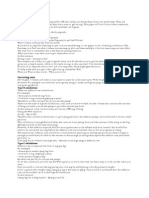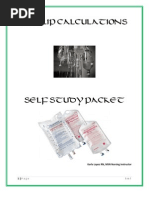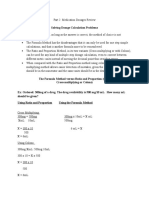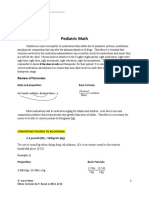Dosage Calculation Review Part 3 - Flow Rate Calculations
Uploaded by
NursyNurseDosage Calculation Review Part 3 - Flow Rate Calculations
Uploaded by
NursyNursePart 3: IV Flow Rate Calculations Content
IV infusions are measured as a flow rate of fluid. This flow rate is a relationship between a Unit
of Volume over a Unit of Time: Volume
Time
Control of flow rates can basically be achieved in two ways: a) Manually or b) Electronically
Electronic Flow Rate control
o Using an electronic method, the most common volume measure used is milliliters
per hour (ml/hr).
Ex: Ordered: 600 mL of a given solution over 3 hr. At how many mL/hr should this
infusion run?
600 mL = X mL X= 600 x 1 X= 200 ml/hr
3 hr 1 hr 3
Manual Flow Rate control
o The most commonly manual method used is an Infusion Set with a Roller Clamp, a
device that allows the set of flow rates through the counting of drops falling in a Drip
Chamber over a minute.
o Using a manual infusion set, the flow rate is measured in drops per minute
(gtts/min).
o There are FOUR types of manual infusion sets according to the SIZE of the drops in
which the Drip Chamber is calibrated (Drop Factor):
MACRODRIPS:
Drop Factor 10: 10 drops = 1 mL (10 gtts/mL)
Drop Factor 15: 15 drops = 1 mL (15 gtts/mL)
Drop Factor 20: 20 drops = 1 mL (20 gtts/mL)
MICRODRIP:
Drop Factor 60: 60 drops = 1 mL (60 gtts/mL)
To calculate IV flow in gtts/min the following formula can be used:
V (volume in mL to be infused) x F (drop factor) = gtts/min
T (time in minutes)
Ex: 1. Ordered: 1,200 mL of a given solution over 10 hours. At how many gtts/min would
you infuse the ordered solution using an infusion set with a drop factor of 20 gtts/mL?
V x F = gtts/min 1200 x 20 = gtts/min Answer: 40 gtts/min
T 600
Infusion Time
IV infusion time is calculated by dividing the volume to be infused by the ml/hr flow rate.
Ex. Calculate the infusion time for 400 mL of a given solution ordered to run at 60 mL/hr.
60 mL = 400 mL X= 400 x 1 X= 6.67 hr 60 min/hr x 0.67 = 40.2 = 40 min
1 hr X hr 60
Infusion time = 6 hours 40 min
Completion Time
The completion time is calculated by adding the infusion time to the time the IV was started.
Ex. An IV started at 0600 is to complete in 4 hr 30 min. Calculate the completion time.
0600 Completion time: 10:30 am
+ 430
1030
Ex: An IV of 1000 has been ordered to run at 300 ml/hr. It was started at 10:40 am.
Calculate the completion time.
1000 ml – 300 ml = 700 ml at 1140
700 ml – 300 ml = 400 ml at 1240
400 ml – 300 ml = 100 ml at 1340
100 ml ÷ 300 ml/hr = 0.33 = 0.33 hr 60 min/hr x 0.33 hr = 20 min
1340 + 20 min = 1400 = 2:00 pm Completion time = 2:00 pm
Medication Math Calculation Practice
Helpful Hints:
Weight conversion from pounds (lbs) to kilograms (kg): 2.2 lbs = 1 kg
Remember: when converting weight, always round to the nearest 10th place.
Temperature conversion formula: To convert from °F to °C; first, subtract 32 from degrees
Fahrenheit; then multiply by 5; and finally, divide by 9. Remember to round to the nearest 10th
place. Mathematical formula: °F – 32 × 5 ÷ 9 = °C
1. Convert 247 lbs to kg (answer: 112.3 kg)
2. The physician orders Macrobid 0.5 mg/kg for a client weighing 174 lbs. How many mg will
the nurse administer to this client? Round final answer to the nearest 10th place.
(answer: 0.5 mg × 79.1 kg = 39.6
mg)
3. Convert 98.6° F to °C (answer: 37° C)
4. The physician orders Heparin 5,000 units in 500 mL of NS to infuse at 300 units/hr. How
many mL/hr will the nurse infuse? (answer: 300 ÷ 5,000 × 500 = 30 mL/hr)
5. The physician order reads: “If temp is > 38.0° C administer Tylenol 2 mg/kg po”. The client
weighs 206 lbs and has a temperature of 100.5° F. First, what is the temperature in °C? Will
you administer the Tylenol? If yes, how many mg will the nurse administer (round to the nearest
10th place)?
(answer: Temp = 38.1° C)
(answer: Will you administer Tylenol? YES)
(answer: 2 mg × 93.6 kg = 187.2 mg)
You might also like
- Pharmacy Calculation Workbook: 250 Questions to Prepare for the NAPLEX and PTCB ExamFrom EverandPharmacy Calculation Workbook: 250 Questions to Prepare for the NAPLEX and PTCB Exam5/5 (3)
- Drug Dosage and IV Rates Calculations PDFNo ratings yetDrug Dosage and IV Rates Calculations PDF6 pages
- Perception, Opportunity, and Profit: Israel M. KirznerNo ratings yetPerception, Opportunity, and Profit: Israel M. Kirzner148 pages
- Chapter 14 Intravenous Solutions, Equipment, and CalculationsNo ratings yetChapter 14 Intravenous Solutions, Equipment, and Calculations48 pages
- Chapter 14 Intravenous Solutions, Equipment, and Calculations100% (1)Chapter 14 Intravenous Solutions, Equipment, and Calculations48 pages
- 2016 NUR1021 Calculation of Basic IV Drip Rates - Instructor100% (2)2016 NUR1021 Calculation of Basic IV Drip Rates - Instructor39 pages
- IV Drip Calculations Self Study Packet - Lopez100% (5)IV Drip Calculations Self Study Packet - Lopez25 pages
- MATH 102 Chapter 8 Calculation of Basic IV Drip Rates100% (1)MATH 102 Chapter 8 Calculation of Basic IV Drip Rates15 pages
- MATH 102 Chapter 8 Calculation of Basic IV Drip RatesNo ratings yetMATH 102 Chapter 8 Calculation of Basic IV Drip Rates16 pages
- Computation of Drugs and Solutions Edited Version 2014 MVINo ratings yetComputation of Drugs and Solutions Edited Version 2014 MVI27 pages
- Dosage Calculations/Formulas For Nursing Students100% (1)Dosage Calculations/Formulas For Nursing Students10 pages
- Drugs and Ivf Calculation: Jessica M. Dela Cruz, RN, MSNNo ratings yetDrugs and Ivf Calculation: Jessica M. Dela Cruz, RN, MSN10 pages
- reviewer-and-practice-questions-quiz-for-IV-flow-rate-calculations-and-formulaNo ratings yetreviewer-and-practice-questions-quiz-for-IV-flow-rate-calculations-and-formula9 pages
- Calculating IV Infusion and Completion Times: ObjectivesNo ratings yetCalculating IV Infusion and Completion Times: Objectives14 pages
- Dose Ordered Dose Available X Volume Available: O Calculate Rate Using MinutesNo ratings yetDose Ordered Dose Available X Volume Available: O Calculate Rate Using Minutes27 pages
- Dosage Calculation: Prepared by Hina Karim SR NES InstructorNo ratings yetDosage Calculation: Prepared by Hina Karim SR NES Instructor33 pages
- IV Calculation Intro and Practice Answer KeyNo ratings yetIV Calculation Intro and Practice Answer Key6 pages
- DRILLS - DRUG AND INTRAVENOUS CALCULATIONSNo ratings yetDRILLS - DRUG AND INTRAVENOUS CALCULATIONS18 pages
- 15: Medication and Intravenous Administration: Practice QuestionsNo ratings yet15: Medication and Intravenous Administration: Practice Questions15 pages
- Pocket Card Common Drug Calculations February 2023No ratings yetPocket Card Common Drug Calculations February 20236 pages
- Dimensional Analysis For Nursing StudentsFrom EverandDimensional Analysis For Nursing StudentsNo ratings yet
- Procedure Checklist Chapter 26, Skill 26-04: Obtaining A Wound CultureNo ratings yetProcedure Checklist Chapter 26, Skill 26-04: Obtaining A Wound Culture1 page
- Dosage Calculation Review Part 2 - Medication DosagesNo ratings yetDosage Calculation Review Part 2 - Medication Dosages2 pages
- Procedure Checklist Chapter 38, Skill 38-01: Administering IV Medication Via PRN Lock or IV LineNo ratings yetProcedure Checklist Chapter 38, Skill 38-01: Administering IV Medication Via PRN Lock or IV Line2 pages
- Procedure Checklist Chapter 38, Skill 38-08: Discontinuing An IV Infusion or PRN LockNo ratings yetProcedure Checklist Chapter 38, Skill 38-08: Discontinuing An IV Infusion or PRN Lock1 page
- Procedure Checklist Chapter 37, Skill 37-01: Reconstituting and Withdrawing Medication From A VialNo ratings yetProcedure Checklist Chapter 37, Skill 37-01: Reconstituting and Withdrawing Medication From A Vial2 pages
- Procedure Checklist Chapter 38, Skill 38-03: Converting An IV Infusion To A PRN LockNo ratings yetProcedure Checklist Chapter 38, Skill 38-03: Converting An IV Infusion To A PRN Lock2 pages
- Effect of Vulgar Content in Kenyan MusicNo ratings yetEffect of Vulgar Content in Kenyan Music21 pages
- Perencangan Esin Cetak Kue Tradisional Aceh (Karra)No ratings yetPerencangan Esin Cetak Kue Tradisional Aceh (Karra)7 pages
- 2021T3R6 Release Notes Outfitting Plant and IMNo ratings yet2021T3R6 Release Notes Outfitting Plant and IM54 pages
- Date Sheet Dae 1st 2nd 3rd Year A 2023 TheoryNo ratings yetDate Sheet Dae 1st 2nd 3rd Year A 2023 Theory94 pages
- A Social Ecological Approach Tobelonging in LGBTQ+ PeopleNo ratings yetA Social Ecological Approach Tobelonging in LGBTQ+ People17 pages
- Pollution Prevention From Chemical ProcessesNo ratings yetPollution Prevention From Chemical Processes17 pages
- A Practical Approach To Monitoring Recovery .7No ratings yetA Practical Approach To Monitoring Recovery .79 pages
- CPA_ANSI_Standard_A208_1_Particleboard_2016No ratings yetCPA_ANSI_Standard_A208_1_Particleboard_201618 pages
- Computer Fundamental - I Practical FileNo ratings yetComputer Fundamental - I Practical File32 pages
- Iisco Steel Plant: Employment Notification Number: 2014/3No ratings yetIisco Steel Plant: Employment Notification Number: 2014/35 pages
- Download Ultra Wide 4k Car Blurring the Line Between Zoom and Action Wallpaper Wallpapers.comNo ratings yetDownload Ultra Wide 4k Car Blurring the Line Between Zoom and Action Wallpaper Wallpapers.com1 page
- Lesson01 Position Displacement and Velocity Worksheets0% (1)Lesson01 Position Displacement and Velocity Worksheets3 pages





































































































